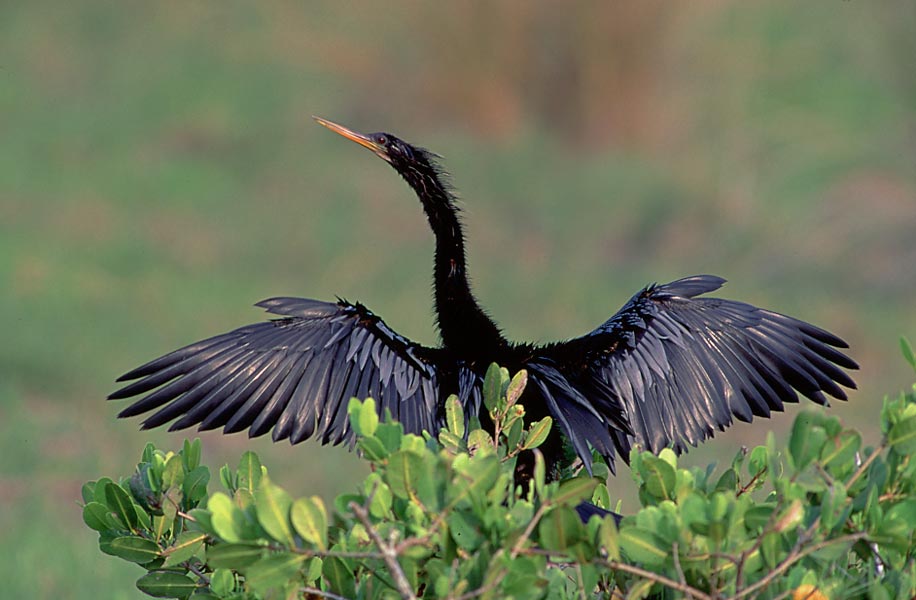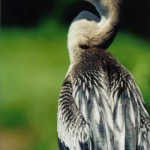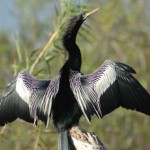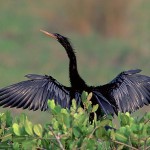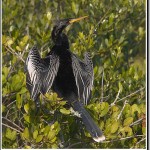Anhinga Facts
Scientific Classification of Anhinga: Anhinga Anhinga
Kingdom of Anhinga: Animalia
Phylum of Anhinga: Chordata
Class of Anhinga: Aves
Order of Anhinga: Pelecaniformes
Family of Anhinga: Anhingidae
Genus of Anhinga: Anhinga
Species of Anhinga: A. anhinga
Anhinga
Anhinga, also known as the devil bird or the birds of dark water is a native of warmer regions of America. Their long neck and strong beak have given them adjectives like the snake bird or the water turkey, by which they are also referred. These birds like chasing behind their prey for about several hours. They have wonderful swimming and diving abilities. Their body has water absorbent feather that allows smooth diving, a unique adaptive feature that is rare in birds.
Pictures of Anhinga
Some Interesting Things about Anhinga
- These species are called snakebirds due to their long neck that looks a bit snakelike. They usually bring out the neck out from water during swimming.
- Other names that they have are Darter, Water Turkey, and American Darter.
- The name has actually been deciphered from the Tupi language of Brazil, meaning devil bird.
- The vertebrates are so beautifully designed, that it allows them to attack and stab strongly with the help of their beak.
- The juvenile ones can swim very nicely.
Distribution of Anhinga
One can get these species in the regions of South America, South Eastern United States and some places in Argentina. Additionally, they can also be found in warmer locations in North America.
Migration of Anhinga
These species prefer to move from one place to another for warmer habitat. During winter, they usually migrate towards the equator along with other birds. In USA, they migrate to the regions of Wisconsin and Pennsylvania. Temperature and warm sunshine generally determines the migration.
Characteristics of Anhinga
- Length of Anhinga: Their body length varies somewhere around 89 cm.
- Weight of Anhinga: The weight of these species is somewhat about 1.22 kgs
- Wingspan of Anhinga: The wingspan is about 3.7 feet in size.
- Color of Anhinga: These species are silverfish white with dots on the upper portion of the wings and body. The entire body is however, blackish green and appears very glossy. The tail is appears from black to blue while the tip has white colored feathers. The female counterparts appear brownish black with brown head, neck, and chest. The appearance of both the females and males is almost the same. The younger ones are born brown.
- Feet of Anhinga: They have webbed feet that are generally yellow in color.
- Beak of Anhinga: The beak of these species is sharp, long and pointed. Also the beak sizes about 2 times the length of the head.
- Neck of Anhinga: These species have a thin and long neck.
Food Habits of Anhinga
These species mostly eat fishes but also prefer crustaceans, tadpoles, water snakes, and small alligators. They usually stalk their food and attack by spearing their prey with the sharp beak.
Habitat of Anhinga
These species prefer to dwell in ponds, swamps, rivers and other such areas of slow moving enclosed waters. They can also be found in the regions of freshwater but only during drought.
Sub Species of Anhinga
There are two sub species:
- A.a. anhinga: The variant of the bird is to be found in eastern parts of Andes of South America which includes Trinidad &Tobago.
- A.a Leucogaster: These sub-species are found in Mexico, Cuba, southern United States, and Grenada.
Behavior of Anhinga
- These species prefer to hunt inside water either by swimming or by diving.
- They like to stay in small clans.
- They spread their tail and feathers in a semicircular formation to dry them up when on land.
- The reduction in buoyancy level due to the absence of waterproof feathers helps them swimming deep in water. Heavy bones also assist in the process.
Flight of Anhinga
These birds fly very high and could reach up to thousands of feet above ground level. While flying, they always keep their wings straight and flat.
Mating in Anhinga
- The male counterparts urge to collect raw materials like leaves, twigs, catkins and willows to make the nest while the females take up the creative task of actually making up the nest.
- They usually make their nests on trees that are close to the water. After this, the female lays about 3-5 light blue colored eggs in the nest. The juveniles get active after 14-21 days.
Conservation Status of Anhinga
These species are quite abundant and do not list on the red list published by the IUCN. However, in USA, they have been protected by the Migratory Bird Treaty Act (1918).
